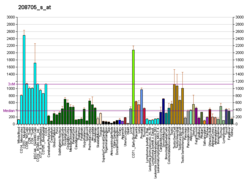
KNOWPIA
WELCOME TO KNOWPIA
Summary
Eukaryotic translation initiation factor 5 is a protein that in humans is encoded by the EIF5 gene.[5][6]
| EIF5 | |||||||||||||||||||||||||||||||||||||||||||||||||||
|---|---|---|---|---|---|---|---|---|---|---|---|---|---|---|---|---|---|---|---|---|---|---|---|---|---|---|---|---|---|---|---|---|---|---|---|---|---|---|---|---|---|---|---|---|---|---|---|---|---|---|---|
 | |||||||||||||||||||||||||||||||||||||||||||||||||||
| |||||||||||||||||||||||||||||||||||||||||||||||||||
| Identifiers | |||||||||||||||||||||||||||||||||||||||||||||||||||
| Aliases | EIF5, EIF-5, EIF-5A, eukaryotic translation initiation factor 5, Eukaryotic initiation factor 5 | ||||||||||||||||||||||||||||||||||||||||||||||||||
| External IDs | OMIM: 601710 MGI: 95309 HomoloGene: 49610 GeneCards: EIF5 | ||||||||||||||||||||||||||||||||||||||||||||||||||
| |||||||||||||||||||||||||||||||||||||||||||||||||||
| |||||||||||||||||||||||||||||||||||||||||||||||||||
| |||||||||||||||||||||||||||||||||||||||||||||||||||
| |||||||||||||||||||||||||||||||||||||||||||||||||||
| |||||||||||||||||||||||||||||||||||||||||||||||||||
| Wikidata | |||||||||||||||||||||||||||||||||||||||||||||||||||
| |||||||||||||||||||||||||||||||||||||||||||||||||||
EIF5 is a GTPase-activating protein.[7]
References edit
- ^ a b c GRCh38: Ensembl release 89: ENSG00000100664 – Ensembl, May 2017
- ^ a b c GRCm38: Ensembl release 89: ENSMUSG00000021282 – Ensembl, May 2017
- ^ "Human PubMed Reference:". National Center for Biotechnology Information, U.S. National Library of Medicine.
- ^ "Mouse PubMed Reference:". National Center for Biotechnology Information, U.S. National Library of Medicine.
- ^ Si K, Das K, Maitra U (Aug 1996). "Characterization of multiple mRNAs that encode mammalian translation initiation factor 5 (eIF-5)". J Biol Chem. 271 (28): 16934–8. doi:10.1074/jbc.271.28.16934. PMID 8663286.
- ^ "Entrez Gene: EIF5 eukaryotic translation initiation factor 5".
- ^ Das S, Ghosh R, Maitra U (March 2001). "Eukaryotic translation initiation factor 5 functions as a GTPase-activating protein". J. Biol. Chem. 276 (9): 6720–6. doi:10.1074/jbc.M008863200. PMID 11092890.
External links edit
- Cap-dependent translation initiation from Nature Reviews Microbiology. A good image and overview of the function of initiation factors
- PDBe-KB provides an overview of all the structure information available in the PDB for Human Eukaryotic translation initiation factor 5 (EIF5)
Further reading edit
- Das S, Maiti T, Das K, Maitra U (1998). "Specific interaction of eukaryotic translation initiation factor 5 (eIF5) with the beta-subunit of eIF2". J. Biol. Chem. 272 (50): 31712–8. doi:10.1074/jbc.272.50.31712. PMID 9395514.
- Bandyopadhyay A, Maitra U (1999). "Cloning and characterization of the p42 subunit of mammalian translation initiation factor 3 (eIF3): demonstration that eIF3 interacts with eIF5 in mammalian cells". Nucleic Acids Res. 27 (5): 1331–7. doi:10.1093/nar/27.5.1331. PMC 148320. PMID 9973622.
- Das S, Maitra U (2000). "Mutational analysis of mammalian translation initiation factor 5 (eIF5): role of interaction between the beta subunit of eIF2 and eIF5 in eIF5 function in vitro and in vivo". Mol. Cell. Biol. 20 (11): 3942–50. doi:10.1128/MCB.20.11.3942-3950.2000. PMC 85746. PMID 10805737.
- Choi SK, Olsen DS, Roll-Mecak A, et al. (2000). "Physical and functional interaction between the eukaryotic orthologs of prokaryotic translation initiation factors IF1 and IF2". Mol. Cell. Biol. 20 (19): 7183–91. doi:10.1128/MCB.20.19.7183-7191.2000. PMC 86272. PMID 10982835.
- Das S, Ghosh R, Maitra U (2001). "Eukaryotic translation initiation factor 5 functions as a GTPase-activating protein". J. Biol. Chem. 276 (9): 6720–6. doi:10.1074/jbc.M008863200. PMID 11092890.
- Wiemann S, Weil B, Wellenreuther R, et al. (2001). "Toward a catalog of human genes and proteins: sequencing and analysis of 500 novel complete protein coding human cDNAs". Genome Res. 11 (3): 422–35. doi:10.1101/gr.GR1547R. PMC 311072. PMID 11230166.
- Asano K, Shalev A, Phan L, et al. (2001). "Multiple roles for the C-terminal domain of eIF5 in translation initiation complex assembly and GTPase activation". EMBO J. 20 (9): 2326–37. doi:10.1093/emboj/20.9.2326. PMC 125443. PMID 11331597.
- Majumdar R, Bandyopadhyay A, Deng H, Maitra U (2002). "Phosphorylation of mammalian translation initiation factor 5 (eIF5) in vitro and in vivo". Nucleic Acids Res. 30 (5): 1154–62. doi:10.1093/nar/30.5.1154. PMC 101238. PMID 11861906.
- Strausberg RL, Feingold EA, Grouse LH, et al. (2003). "Generation and initial analysis of more than 15,000 full-length human and mouse cDNA sequences". Proc. Natl. Acad. Sci. U.S.A. 99 (26): 16899–903. Bibcode:2002PNAS...9916899M. doi:10.1073/pnas.242603899. PMC 139241. PMID 12477932.
- Marintchev A, Kolupaeva VG, Pestova TV, Wagner G (2003). "Mapping the binding interface between human eukaryotic initiation factors 1A and 5B: a new interaction between old partners". Proc. Natl. Acad. Sci. U.S.A. 100 (4): 1535–40. Bibcode:2003PNAS..100.1535M. doi:10.1073/pnas.0437845100. PMC 149867. PMID 12569173.
- Ota T, Suzuki Y, Nishikawa T, et al. (2004). "Complete sequencing and characterization of 21,243 full-length human cDNAs". Nat. Genet. 36 (1): 40–5. doi:10.1038/ng1285. PMID 14702039.
- Gerhard DS, Wagner L, Feingold EA, et al. (2004). "The status, quality, and expansion of the NIH full-length cDNA project: the Mammalian Gene Collection (MGC)". Genome Res. 14 (10B): 2121–7. doi:10.1101/gr.2596504. PMC 528928. PMID 15489334.
- Rual JF, Venkatesan K, Hao T, et al. (2005). "Towards a proteome-scale map of the human protein-protein interaction network". Nature. 437 (7062): 1173–8. Bibcode:2005Natur.437.1173R. doi:10.1038/nature04209. PMID 16189514. S2CID 4427026.
- Homma MK, Wada I, Suzuki T, et al. (2005). "CK2 phosphorylation of eukaryotic translation initiation factor 5 potentiates cell cycle progression". Proc. Natl. Acad. Sci. U.S.A. 102 (43): 15688–93. Bibcode:2005PNAS..10215688H. doi:10.1073/pnas.0506791102. PMC 1266118. PMID 16227438.
- Conte MR, Kelly G, Babon J, et al. (2006). "Structure of the eukaryotic initiation factor (eIF) 5 reveals a fold common to several translation factors". Biochemistry. 45 (14): 4550–8. doi:10.1021/bi052387u. PMID 16584190.
- Bieniossek C, Schütz P, Bumann M, et al. (2006). "The crystal structure of the carboxy-terminal domain of human translation initiation factor eIF5". J. Mol. Biol. 360 (2): 457–65. doi:10.1016/j.jmb.2006.05.021. PMID 16781736.
- Olsen JV, Blagoev B, Gnad F, et al. (2006). "Global, in vivo, and site-specific phosphorylation dynamics in signaling networks". Cell. 127 (3): 635–48. doi:10.1016/j.cell.2006.09.026. PMID 17081983.









